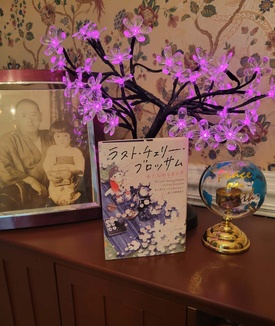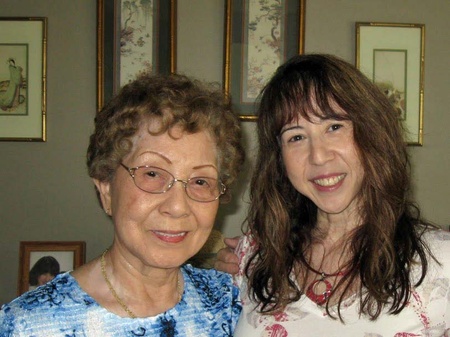Daughter's illness and mother's confession

There is a novel called "Last Cherry Blossom." Set in Hiroshima during wartime, the main characters are an impressionable young girl named Yuriko, her kind-hearted father, and her aunt, who lives with her and from whom Yuriko feels a distance. The latter half of the novel describes the day of August 6th, when the city of Hiroshima was reduced to ashes, and their fate after that. The first half, leading up to the atomic bomb, is detailed in its depiction of the simple but polite lifestyle of Japanese people during wartime. In my mind, the vivid personalities of each member of Yuriko's family, their subtle emotions, and their daily interactions unfolded as images. It was as if I was watching a film by Yasujiro Ozu, one of my favorites. But then the cruel day of the atomic bomb arrives. The modest, happy, peaceful daily life that the family had lived together until then was destroyed in an instant, and they were forced to bear deep sadness and physical pain.
I was surprised to learn that this novel was written by an American woman named Catherine Birkinshaw. How was she able to so vividly recreate the state of Hiroshima during the war? The answer is that her mother, Toshiko, who was born in Hiroshima, was the model for the main character, Yuriko.
I had the opportunity to interview Katherine, who lives on the East Coast, online, and asked her about the process of completing the novel and her identity as a second-generation Japanese American with an American father and a Japanese mother. Her parents met in Japan in 1959, got married, and moved to the United States. Katherine was born in 1969 in Rhode Island.
In fact, Catherine recalls that she didn't know much about Toshiko's past as an atomic bomb survivor until several years ago when she decided to write this novel.
"I developed a sympathetic nervous system disease when I was 30 and was forced to give up my job. My daughter was only four years old and my husband had to work. So my mother spent time with me to look after me. At that time, I was in despair because of my illness. I couldn't do anything myself, and I wanted to be a good mother and take care of my daughter, but I couldn't. Seeing me like that, my mother began to tell me about her experience in Hiroshima. After the bombing, my mother even tried to commit suicide. But if she had done that, I would never have been born, and my daughter would never have existed. So my mother encouraged me by saying, 'You will be fine.'"
"What a cool mushroom cloud."
After that, Katherine underwent surgery and was able to leave the wheelchair. Then, when Katherine's daughter was in the seventh grade, something happened.
"When my daughter was studying U.S. history in middle school, one of the students saw the mushroom cloud and said, 'What a cool mushroom!' She was shocked to hear that. I decided that for my children's sake, I had to tell them the facts about the atomic bomb."
Until then, due to the trauma, Toshiko had turned her back on Hiroshima, to the point that when people asked her where she was from, she would answer, "I'm from Tokyo." But at that moment, her granddaughter's classmate commented, "That looks like a cool mushroom cloud," and this noble sense of purpose that sprouted within Catherine resonated deeply with her: "We need to make sure that the children who will create the future understand the tragedy caused by the atomic bomb and the importance of peace."
When Catherine began her lecture in front of the junior high school students, she could feel the audience's reactions one after another. When she told Toshiko about this, her mother shed tears. It was the moment when Toshiko, who had seemed to have firmly closed her heart up until then, was finally able to open up. Catherine added, "The student who said 'cool mushroom cloud' didn't mean it in a spiteful way. It was his complete ignorance of historical facts that led him to make that comment."
Katherine gave many talks at junior high schools, and then she decided to write a novel based on her mother's experiences. In 2014, she signed a contract with a publisher for "Last Cherry Blossom."
"My mother was very proud. By writing this book, I wanted to convey that even in an enemy country, there were people living there. If people are from different countries or in different positions, they may not see it as something that affects them. However, we are all human beings just like them, and I strongly hoped that people would understand that if the positions were reversed, this could have happened to them."
Although Katherine had no experience as a professional writer, she carefully researched wartime Japan, had Toshiko read a draft, and asked her opinion on whether it was an accurate depiction. Due to her illness, it was sometimes difficult for her to hold a pen, and the preparation took time, but her hard work paid off. And Toshiko passed away before the book was published. Still, being able to announce that it was going to be published must have been the greatest act of filial piety.
Speak out for peace
Next, I asked Catherine whether she felt that she had something Japanese inside her.
"When I was a child, there was still a lot of prejudice and hatred towards Japan in America. So my mother didn't teach me Japanese and all our conversations were in English. Also, at school, other kids would say mean things to my mother like, 'What are you doing here? Go back to Japan,' and I myself was discriminated against by my teachers because I'm half Japanese. I was the only Asian student there until a Filipino student transferred in when I was in the fourth grade. My mother obtained American citizenship and went by the American name "Betty." As a child, I was even convinced that my mother's official name was Elizabeth. And so I grew up without having the opportunity to learn Japanese."
Finally, when asked what her dreams are for five years from now, she replied, "I intend to do what I can to strengthen the ties between countries and to create a peaceful world. My daughter chose to minor in Japanese at university, and as a third-generation Japanese-American, she wants to speak out for peace. I believe that our mother in heaven is watching over me and my daughter."
In the past, I have interviewed several atomic bomb survivors, Keiko Sasamori and Kazu Sueishi, as well as Fumiko Yonetani, a writer who opposes nuclear weapons. However, Sueishi has already passed away, and there are only a few people who can convey their experiences of the atomic bomb. I strongly hope that people like Catherine, who can convey their parental experiences to society in the form of novels and lectures, especially to children who will be responsible for the future of the world, will become more active.
Reference (all written by the author)
© 2022 Keiko Fukuda






